The 7 Best Foods for Gut Health, Plus Other Tips from a Registered Dietitian
Nutrition plays a huge role in the health of your gut microbiome.
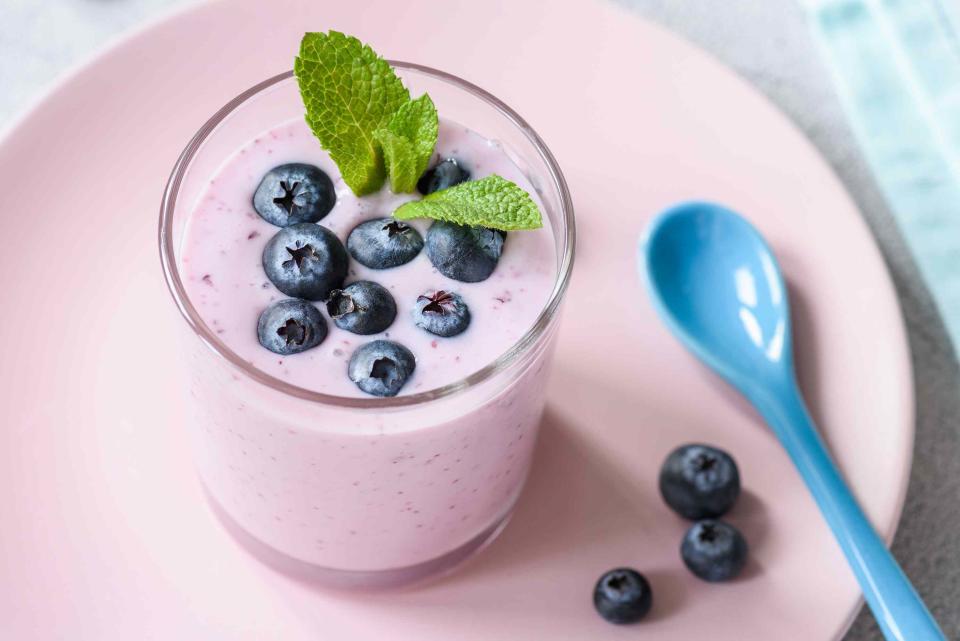
Getty Images
Medically reviewed by Kristy Del Coro, MS, RDN, LDNFact checked by Isaac Winter
When it comes to popular health topics and trends, all eyes are on the gut microbiome—its importance for overall health and the many actions we can take everyday to improve its vitality. Over recent years, interest in the gut microbiome has skyrocketed, and research surrounding it has become more robust. That means eating the right foods for gut health has come to the forefront of many people's minds lately.
What Is the Gut Microbiome?
Found primarily in the large intestine, the gut microbiome is a group of trillions of micro-organisms—mostly bacteria, but also some yeast varieties and viruses. As more studies are completed, we’re finding that these microorganisms may actually be steering the ship when it comes to so many different health outcomes.
What Can Help and Hurt Your Gut Microbiome?
Several genetic and lifestyle factors can influence the balance of microbes in the gut, both directly and indirectly, including exercise, stress levels, sleep, hydration status, and, of course, nutrition. What you eat really is the foundation of the microbiome. The best foods for gut health are those rich in good gut bacteria, rich in nutrients to feed all that good bacteria, and rich in compounds that temper and prevent inflammation.
Armed with all this information on the importance of gut health for overall health, you may be raring to go to start boosting your microbiome. Well, thankfully, one of the best ways to fix your gut is to make informed food choices.
The Best Foods to Eat for Gut Health
Black Beans
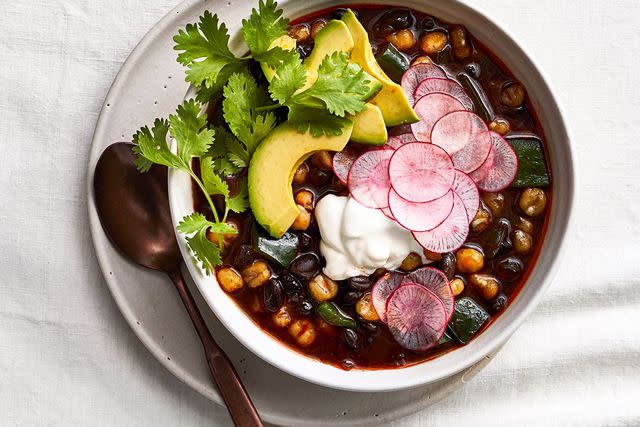
VICTOR PROTASIO
Black beans are a fiber powerhouse—and fiber is a key player when it comes to healthy digestion, providing structure to aid regularity. There are two main types of fiber: soluble fiber and insoluble fiber, and we all need both since they provide different benefits. Soluble fiber dissolves in water to form a gel in the gastrointestinal (GI) tract, whereas insoluble fiber does basically the opposite: It does not dissolve in water and adds bulk, helping to keep things moving and prevent constipation.
Certain types of fiber aren’t completely broken down in the digestive process and make it all the way to the intestines. These survivors are really important sources of food for our healthy gut bacteria: Another name for them, which you may be familiar with, are prebiotics (which we’ll get to in a second). While not all sources of fiber are prebiotics, many familiar fiber-rich foods are, including beans and other legumes such as lentils and peas, bananas, apples, asparagus, berries, flaxseed, broccoli, garlic, oats, onions, leafy greens, and tomatoes.
Related: 10 Wholesome (and Easy) High-Fiber Meals
Yogurt
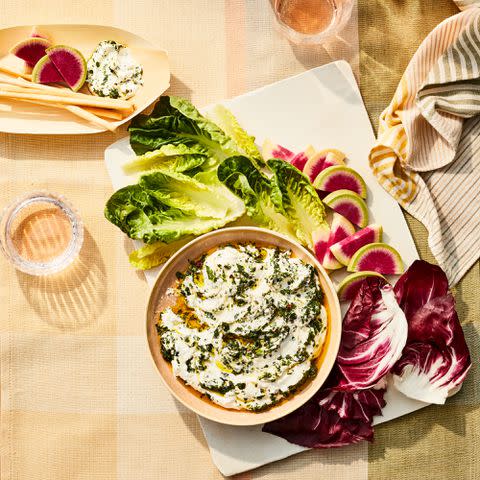
One important way to help build a thriving gut microbiome is to consume foods rich in healthy bacteria, also called probiotics. Probiotic foods are either enriched with bacteria or contain bacteria grown in the food through a metabolic process called fermentation. Yogurt (most of which is fermented) can be an excellent source of probiotics, whether you choose the thick Greek kind, the creamy regular variety, or drinkable yogurt, often called kefir. Just check the label for "live and active cultures" to make sure you're getting plenty of probiotic goodness.
According to a 2022 review of studies published in the journal Food, yogurt's probiotic powers have potential health benefits for a number of gastrointestinal conditions, including lactose intolerance, constipation, and inflammatory bowel disease.
Related: 8 Health Benefits of Greek Yogurt
Miso and Other Fermented Foods
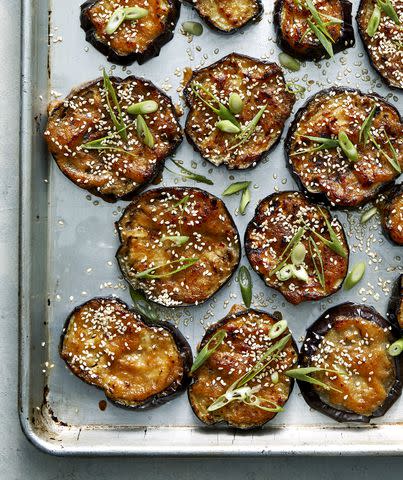
Miso Roasted Eggplant With Sesame Seeds
If you're not big on yogurt, other fermented foods, such as savory miso, can be an excellent source of probiotics, grown through a metabolic process called fermentation. Although some fermented foods, like sourdough bread or beer, don’t contain probiotics, there are many other fantastic ways to eat your probiotics, including sauerkraut, tempeh, kombucha, kimchi, buttermilk, and certain types of pickles (make sure you're choosing pickles that are actually fermented, not just pickled in vinegar).
Related: Fermentation Is the Key to Our Plant-Based Future
Barley
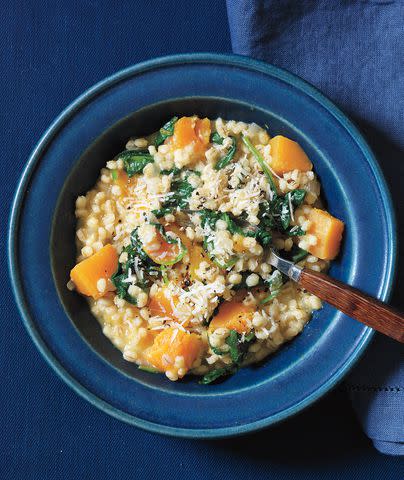
Baked Barley Risotto With Butternut Squash
Barley is an excellent source of prebiotics, which act as food for our intestinal bacteria, helping them to flourish. Like most typical prebiotic foods, they contain soluble fibers that are indigestible by humans, but not by our gut bacteria. Some other examples of prebiotic food sources include onions, leeks, honey, cocoa, flaxseed, seaweed, whole wheat products, dandelion greens, mushrooms, asparagus, cabbage, apples, oats, watermelon, bananas, and chickpeas.
Related: How to Cook Barley for Breakfast
Salmon
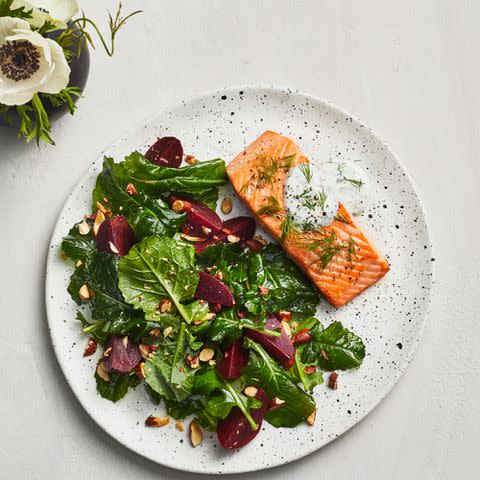
Roasted Salmon with Beet Salad
Salmon is an excellent source of omega-3 fatty acids, which help your body fight and prevent inflammation. Like most anti-inflammatory foods, it's full of vitamins and minerals. Pro-inflammatory foods can irritate the gut and negatively influence the microbiome, especially if consumed in excess, and this can inhibit the biome from carrying out its vital bodily functions. Generally, anti-inflammatory foods will be full of vitamins and minerals. Other anti-inflammatory foods that contain omega-3 fats: walnuts, chia seeds, hemp, salmon, sardines, anchovies, and soybeans.
Related: 8 Ultra-Healthy Foods High in Omega-3s
Berries
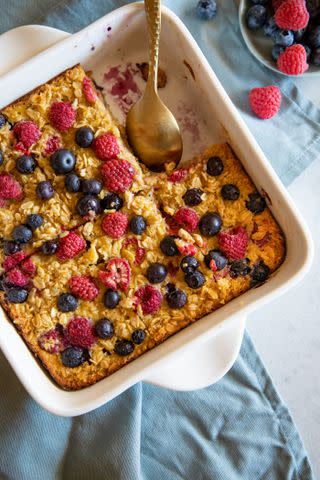
Berries are full of anti-inflammatory plant compounds called polyphenols, which are particularly beneficial for gut health because they have antioxidant properties, encouraging healthy microorganism growth while inhibiting the growth of harmful pathogens in the gut.
Other sources of polyphenols include nuts, dark green veggies, tea, beans, apples, cherries, onions, olives, cloves, capers, oregano, sage, thyme and many more. The list is long, because all plants contain some of these amazing compounds (hence why eating a diet rich in a variety of plants is fantastic for gut health). A good rule of thumb: The more brilliantly colored the plant food is, the more likely it’ll be packed with polyphenols.
Related: The 8 Healthiest Berry Varieties
Baked Versions of Your Favorite Fried Treats
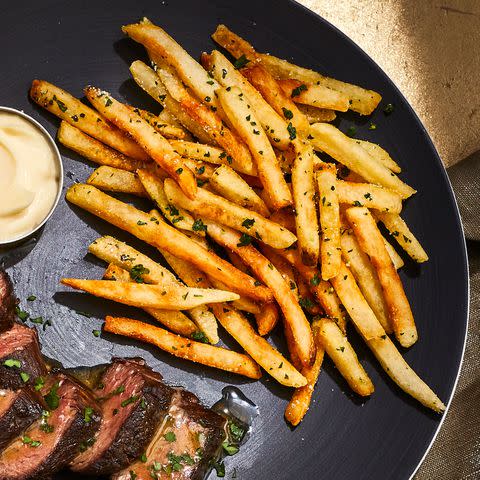
Oven-Baked Garlic-Parsley Shoestring Fries
Of course it's okay to enjoy an order of fries now and then. But when it comes to fried and other inflammatory foods, your gut will thank you for exercising moderation (for instance, this lighter oven-baked version flavored with zesty parsley). Many anti-inflammatory foods either inherently lack fiber or have been stripped of their natural fibers (think: refined grains), so they don't support—or in some cases actively irritate—gut health. That goes for not only fried foods but alcohol, processed foods, and added sugars. Red meat is also something to be careful of, as research has found that consuming red meat can releases a pro-inflammatory metabolite that’s been linked to heart disease. (Plus, there’s robust evidence linking red meat to colon cancer.) Added sugars are also an ingredient to be wary of and limit wherever possible. Not only are they a major inflammatory agent in the gut, but research has shown that added sugars can negatively impact the balance of good and bad bacteria in the gut as well as compromise the gut mucosal barrier, leaving us more susceptible to illness and infection. Artificial sweeteners, too, may disrupt the balance of bacteria in our biome.
Related: 3 Simple Ways to Sweeten Foods Without Sugar (or Anything Artificial)
What Role Does Gut Health Play in Overall Health?
Digestion, Metabolism, and Nutrient Absorption
Given the location of its headquarters, you might guess that the microbiome is charged with healthy digestion and metabolism—and it most certainly is. But it also plays a key role in the synthesis of certain amino acids and vitamins, while helping to potentially break down toxic compounds found in our food.
Immunity
The microbiome contains both beneficial and harmful bacteria, so boosting the population of healthy bacteria in this ecosystem is essential to a healthy immune system too. Plus, the biome plays a large role in the modulation of many different types of immune cells in our body, further establishing it as an MVP in immune health.
Brain Function, Nervous System, Mental Health
The gut microbiome also has a surprisingly deep connection to your mind and mood: The intestines are actually lined with nerve cells that communicate with the central nervous system. This connection, called the gut-brain axis, is a bidirectional communication pathway between these intestinal nerve cells and the central nervous system, of which the brain is the star. And because of this connection, the health of our brains can affect our gut health, and vice versa. In fact, research has shown that the health of our gut microbiome is tied to mood disorders like anxiety and depression, cognitive function, and stress management.
Longevity and Chronic Diseases
Finally, the gut microbiome plays another super-important role in the development and expression of chronic disease. One review done of multiple studies found that the health of the microbiome is closely tied to the prevention (or the expression) of many chronic diseases ranging from metabolic, neurologic, cardiovascular, and respiratory. Some of these include type 1 and 2 diabetes, asthma, inflammatory bowel disease, irritable bowel syndrome, kidney disease, liver disease, and asthma. Plus, gut health has also been found to play a vital role in calcium absorption and bone cell health, helping to maintain healthy bones and prevent osteoporosis.
For more Real Simple news, make sure to sign up for our newsletter!
Read the original article on Real Simple.

